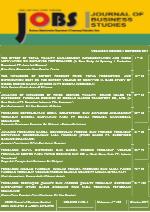The effect of Innovation Products, Lifestyle and Brand Image on Purchase Decision of Datsun Type Cars
DOI:
https://doi.org/10.32497/jobs.v6i2.2540Keywords:
Product Innovation, Lifestyle, Brand Image and Buying DecisionAbstract
Innovation is an important element for creating new opportunities in a car industry business. Each year, vehicle manufacturers issue the latest types of vehicle models. The development of the number of cars in Indonesia is not in line with the sales of Datsun cars at Indomobil's Puri Anjasmoro Semarang branch. The purpose of this study is to determine the influence of product innovation, lifestyle, and brand image on Datsun car purchasing decisions either simultaneously or partially. This research is a quantitative study using a questionnaire approach and literature study with a sample size of 71 respondents. The model used is multiple linear regression analysis Y = -1.129 + 0.105 X1 + 0.424 X2 + 0.510 X3. With the results of the F test, the sig value is 0.000 which shows that simultaneously the variable product innovation, lifestyle and brand image have a significant effect on purchasing decisions. The result of the determination coefficient (R2) is 76.3%, which means that the variable product innovation, lifestyle and brand image contributes to the influence of purchasing decisions. Meanwhile, 23.7% was influenced by other variables outside the model. T test results obtained sig value of product innovation (X1) sig = 0.356 lifestyle (X2) sig = 0.002 and brand image (X3) Sig = 0.000. Based on these results, the product innovation variable has no significant effect on purchasing decisions, while thevariables lifestyle and brand imagehave a significant effect on purchase intention. Based on the research of the three variables above, the Brand Image variable is the variable that most influences the Purchasing DecisionDownloads
Published
Issue
Section
License
Authors who publish with this journal agree to the following terms:
Authors retain copyright and grant the journal right of first publication with the work simultaneously licensed under a Creative Commons Attribution License that allows others to share the work with an acknowledgement of the work's authorship and initial publication in this journal.
Authors are able to enter into separate, additional contractual arrangements for the non-exclusive distribution of the journal's published version of the work (e.g., post it to an institutional repository or publish it in a book), with an acknowledgement of its initial publication in this journal.
Authors are permitted and encouraged to post their work online (e.g., in institutional repositories or on their website) prior to and during the submission process, as it can lead to productive exchanges, as well as earlier and greater citation of published work (See The Effect of Open Access).






